engine JEEP RENEGADE 2018 Owner handbook (in English)
[x] Cancel search | Manufacturer: JEEP, Model Year: 2018, Model line: RENEGADE, Model: JEEP RENEGADE 2018Pages: 356, PDF Size: 6.11 MB
Page 108 of 356
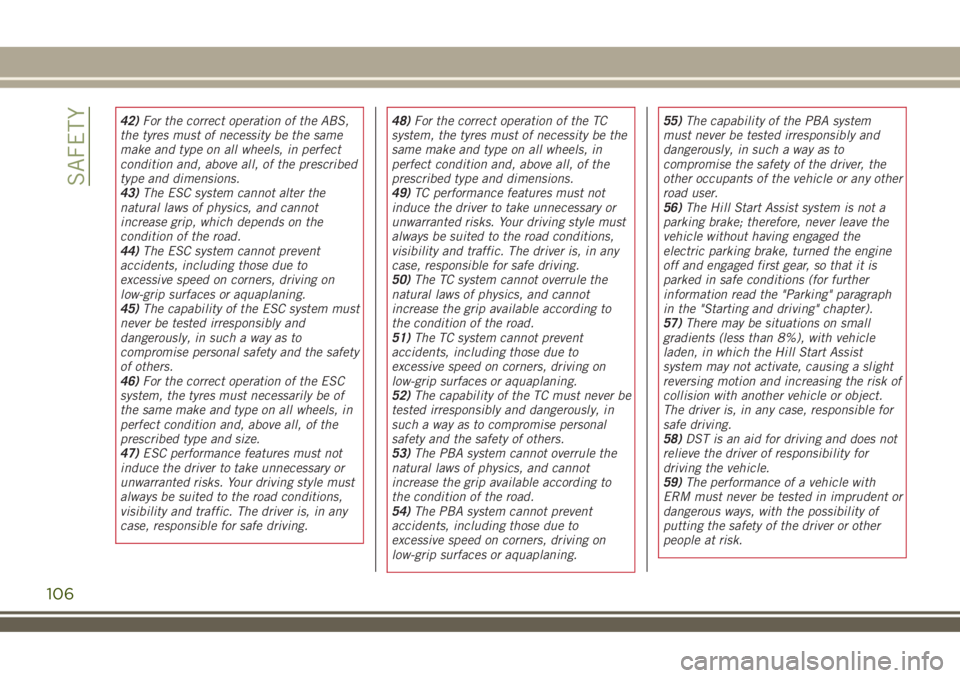
42)For the correct operation of the ABS,
the tyres must of necessity be the same
make and type on all wheels, in perfect
condition and, above all, of the prescribed
type and dimensions.
43)The ESC system cannot alter the
natural laws of physics, and cannot
increase grip, which depends on the
condition of the road.
44)The ESC system cannot prevent
accidents, including those due to
excessive speed on corners, driving on
low-grip surfaces or aquaplaning.
45)The capability of the ESC system must
never be tested irresponsibly and
dangerously, in such a way as to
compromise personal safety and the safety
of others.
46)For the correct operation of the ESC
system, the tyres must necessarily be of
the same make and type on all wheels, in
perfect condition and, above all, of the
prescribed type and size.
47)ESC performance features must not
induce the driver to take unnecessary or
unwarranted risks. Your driving style must
always be suited to the road conditions,
visibility and traffic. The driver is, in any
case, responsible for safe driving.48)For the correct operation of the TC
system, the tyres must of necessity be the
same make and type on all wheels, in
perfect condition and, above all, of the
prescribed type and dimensions.
49)TC performance features must not
induce the driver to take unnecessary or
unwarranted risks. Your driving style must
always be suited to the road conditions,
visibility and traffic. The driver is, in any
case, responsible for safe driving.
50)The TC system cannot overrule the
natural laws of physics, and cannot
increase the grip available according to
the condition of the road.
51)The TC system cannot prevent
accidents, including those due to
excessive speed on corners, driving on
low-grip surfaces or aquaplaning.
52)The capability of the TC must never be
tested irresponsibly and dangerously, in
such a way as to compromise personal
safety and the safety of others.
53)The PBA system cannot overrule the
natural laws of physics, and cannot
increase the grip available according to
the condition of the road.
54)The PBA system cannot prevent
accidents, including those due to
excessive speed on corners, driving on
low-grip surfaces or aquaplaning.55)The capability of the PBA system
must never be tested irresponsibly and
dangerously, in such a way as to
compromise the safety of the driver, the
other occupants of the vehicle or any other
road user.
56)The Hill Start Assist system is not a
parking brake; therefore, never leave the
vehicle without having engaged the
electric parking brake, turned the engine
off and engaged first gear, so that it is
parked in safe conditions (for further
information read the "Parking" paragraph
in the "Starting and driving" chapter).
57)There may be situations on small
gradients (less than 8%), with vehicle
laden, in which the Hill Start Assist
system may not activate, causing a slight
reversing motion and increasing the risk of
collision with another vehicle or object.
The driver is, in any case, responsible for
safe driving.
58)DST is an aid for driving and does not
relieve the driver of responsibility for
driving the vehicle.
59)The performance of a vehicle with
ERM must never be tested in imprudent or
dangerous ways, with the possibility of
putting the safety of the driver or other
people at risk.
106
SAFETY
Page 109 of 356
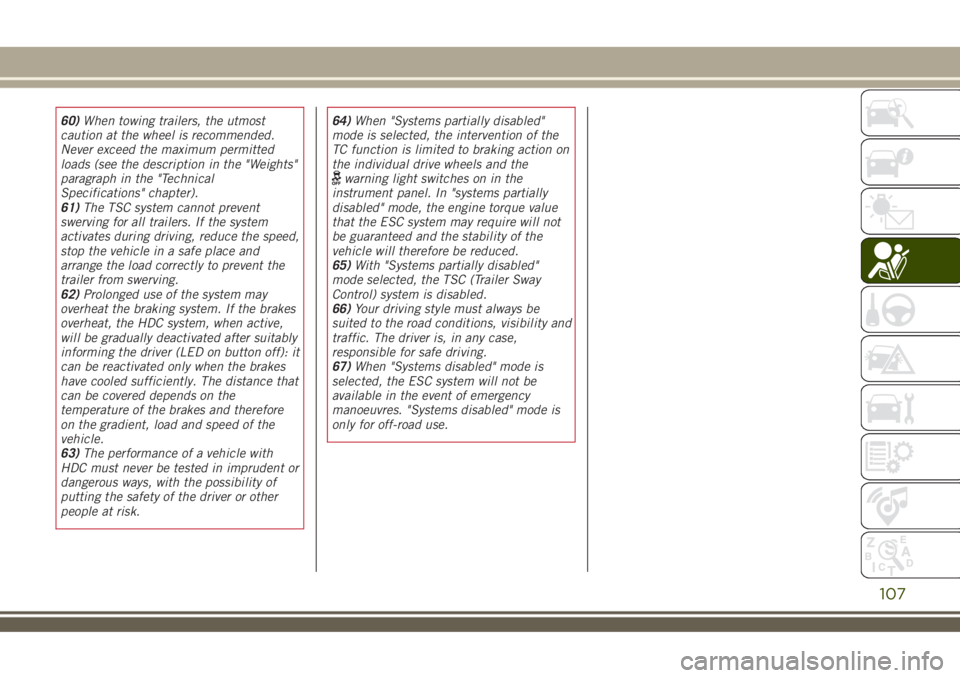
60)When towing trailers, the utmost
caution at the wheel is recommended.
Never exceed the maximum permitted
loads (see the description in the "Weights"
paragraph in the "Technical
Specifications" chapter).
61)The TSC system cannot prevent
swerving for all trailers. If the system
activates during driving, reduce the speed,
stop the vehicle in a safe place and
arrange the load correctly to prevent the
trailer from swerving.
62)Prolonged use of the system may
overheat the braking system. If the brakes
overheat, the HDC system, when active,
will be gradually deactivated after suitably
informing the driver (LED on button off): it
can be reactivated only when the brakes
have cooled sufficiently. The distance that
can be covered depends on the
temperature of the brakes and therefore
on the gradient, load and speed of the
vehicle.
63)The performance of a vehicle with
HDC must never be tested in imprudent or
dangerous ways, with the possibility of
putting the safety of the driver or other
people at risk.64)When "Systems partially disabled"
mode is selected, the intervention of the
TC function is limited to braking action on
the individual drive wheels and the
warning light switches on in the
instrument panel. In "systems partially
disabled" mode, the engine torque value
that the ESC system may require will not
be guaranteed and the stability of the
vehicle will therefore be reduced.
65)With "Systems partially disabled"
mode selected, the TSC (Trailer Sway
Control) system is disabled.
66)Your driving style must always be
suited to the road conditions, visibility and
traffic. The driver is, in any case,
responsible for safe driving.
67)When "Systems disabled" mode is
selected, the ESC system will not be
available in the event of emergency
manoeuvres. "Systems disabled" mode is
only for off-road use.
107
Page 110 of 356
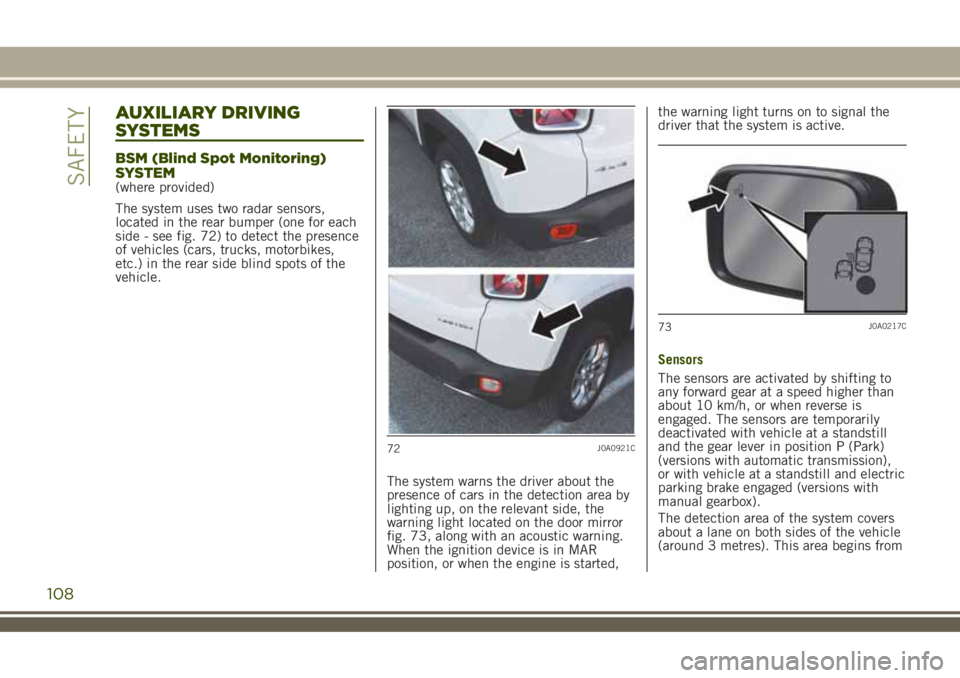
AUXILIARY DRIVING
SYSTEMS
BSM (Blind Spot Monitoring)
SYSTEM
(where provided)
The system uses two radar sensors,
located in the rear bumper (one for each
side - see fig. 72) to detect the presence
of vehicles (cars, trucks, motorbikes,
etc.) in the rear side blind spots of the
vehicle.
The system warns the driver about the
presence of cars in the detection area by
lighting up, on the relevant side, the
warning light located on the door mirror
fig. 73, along with an acoustic warning.
When the ignition device is in MAR
position, or when the engine is started,the warning light turns on to signal the
driver that the system is active.
Sensors
The sensors are activated by shifting to
any forward gear at a speed higher than
about 10 km/h, or when reverse is
engaged. The sensors are temporarily
deactivated with vehicle at a standstill
and the gear lever in position P (Park)
(versions with automatic transmission),
or with vehicle at a standstill and electric
parking brake engaged (versions with
manual gearbox).
The detection area of the system covers
about a lane on both sides of the vehicle
(around 3 metres). This area begins from
72J0A0921C
73J0A0217C
108
SAFETY
Page 112 of 356
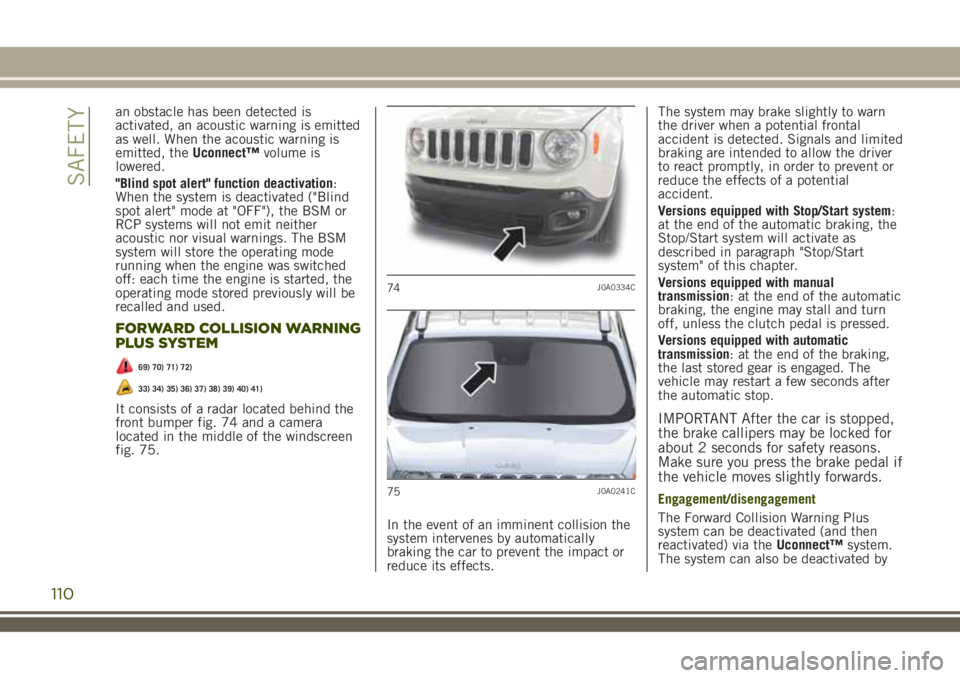
an obstacle has been detected is
activated, an acoustic warning is emitted
as well. When the acoustic warning is
emitted, theUconnect™volume is
lowered.
"Blind spot alert" function deactivation:
When the system is deactivated ("Blind
spot alert" mode at "OFF"), the BSM or
RCP systems will not emit neither
acoustic nor visual warnings. The BSM
system will store the operating mode
running when the engine was switched
off: each time the engine is started, the
operating mode stored previously will be
recalled and used.
FORWARD COLLISION WARNING
PLUS SYSTEM
69) 70) 71) 72)
33) 34) 35) 36) 37) 38) 39) 40) 41)
It consists of a radar located behind the
front bumper fig. 74 and a camera
located in the middle of the windscreen
fig. 75.
In the event of an imminent collision the
system intervenes by automatically
braking the car to prevent the impact or
reduce its effects.The system may brake slightly to warn
the driver when a potential frontal
accident is detected. Signals and limited
braking are intended to allow the driver
to react promptly, in order to prevent or
reduce the effects of a potential
accident.
Versions equipped with Stop/Start system:
at the end of the automatic braking, the
Stop/Start system will activate as
described in paragraph "Stop/Start
system" of this chapter.
Versions equipped with manual
transmission: at the end of the automatic
braking, the engine may stall and turn
off, unless the clutch pedal is pressed.
Versions equipped with automatic
transmission: at the end of the braking,
the last stored gear is engaged. The
vehicle may restart a few seconds after
the automatic stop.IMPORTANT After the car is stopped,
the brake callipers may be locked for
about 2 seconds for safety reasons.
Make sure you press the brake pedal if
the vehicle moves slightly forwards.
Engagement/disengagement
The Forward Collision Warning Plus
system can be deactivated (and then
reactivated) via theUconnect™system.
The system can also be deactivated by
74J0A0334C
75J0A0241C
110
SAFETY
Page 113 of 356
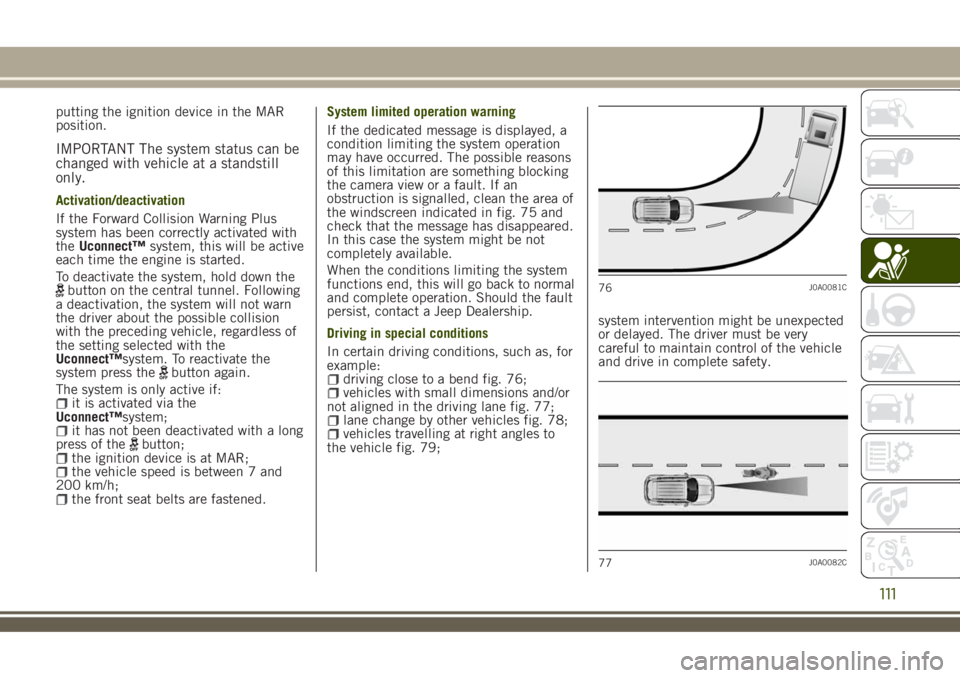
putting the ignition device in the MAR
position.
IMPORTANT The system status can be
changed with vehicle at a standstill
only.
Activation/deactivation
If the Forward Collision Warning Plus
system has been correctly activated with
theUconnect™system, this will be active
each time the engine is started.
To deactivate the system, hold down the
button on the central tunnel. Following
a deactivation, the system will not warn
the driver about the possible collision
with the preceding vehicle, regardless of
the setting selected with the
Uconnect™system. To reactivate the
system press the
button again.
The system is only active if:
it is activated via the
Uconnect™system;
it has not been deactivated with a long
press of thebutton;the ignition device is at MAR;the vehicle speed is between 7 and
200 km/h;
the front seat belts are fastened.System limited operation warning
If the dedicated message is displayed, a
condition limiting the system operation
may have occurred. The possible reasons
of this limitation are something blocking
the camera view or a fault. If an
obstruction is signalled, clean the area of
the windscreen indicated in fig. 75 and
check that the message has disappeared.
In this case the system might be not
completely available.
When the conditions limiting the system
functions end, this will go back to normal
and complete operation. Should the fault
persist, contact a Jeep Dealership.
Driving in special conditions
In certain driving conditions, such as, for
example:
driving close to a bend fig. 76;vehicles with small dimensions and/or
not aligned in the driving lane fig. 77;
lane change by other vehicles fig. 78;vehicles travelling at right angles to
the vehicle fig. 79;system intervention might be unexpected
or delayed. The driver must be very
careful to maintain control of the vehicle
and drive in complete safety.
76J0A0081C
77J0A0082C
111
Page 115 of 356
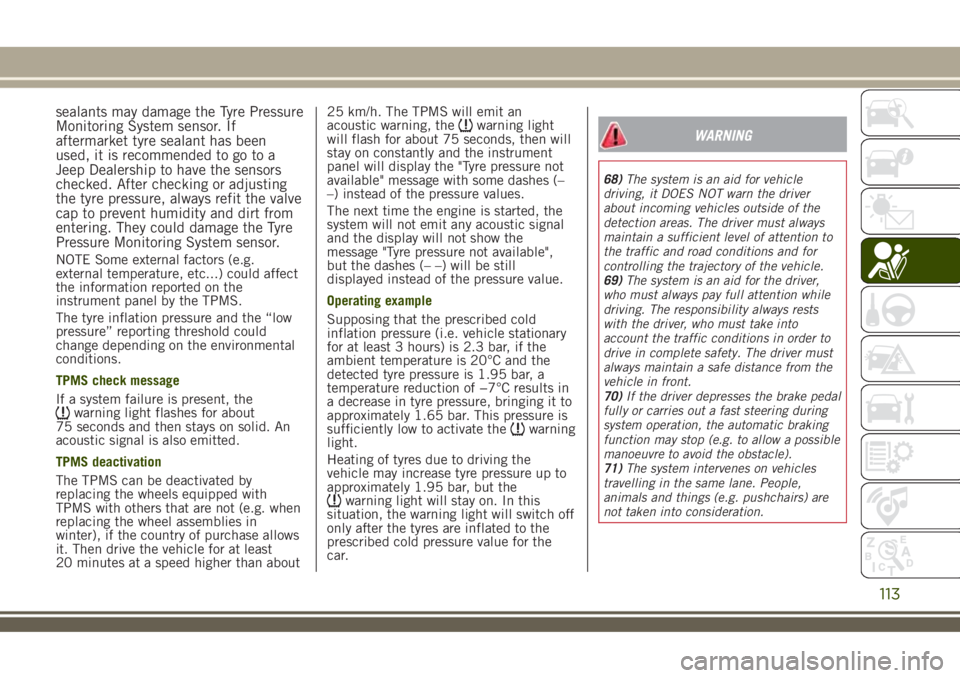
sealants may damage the Tyre Pressure
Monitoring System sensor. If
aftermarket tyre sealant has been
used, it is recommended to go to a
Jeep Dealership to have the sensors
checked. After checking or adjusting
the tyre pressure, always refit the valve
cap to prevent humidity and dirt from
entering. They could damage the Tyre
Pressure Monitoring System sensor.
NOTE Some external factors (e.g.
external temperature, etc...) could affect
the information reported on the
instrument panel by the TPMS.
The tyre inflation pressure and the “low
pressure” reporting threshold could
change depending on the environmental
conditions.
TPMS check message
If a system failure is present, the
warning light flashes for about
75 seconds and then stays on solid. An
acoustic signal is also emitted.
TPMS deactivation
The TPMS can be deactivated by
replacing the wheels equipped with
TPMS with others that are not (e.g. when
replacing the wheel assemblies in
winter), if the country of purchase allows
it. Then drive the vehicle for at least
20 minutes at a speed higher than about25 km/h. The TPMS will emit an
acoustic warning, the
warning light
will flash for about 75 seconds, then will
stay on constantly and the instrument
panel will display the "Tyre pressure not
available" message with some dashes (–
–) instead of the pressure values.
The next time the engine is started, the
system will not emit any acoustic signal
and the display will not show the
message "Tyre pressure not available",
but the dashes (– –) will be still
displayed instead of the pressure value.
Operating example
Supposing that the prescribed cold
inflation pressure (i.e. vehicle stationary
for at least 3 hours) is 2.3 bar, if the
ambient temperature is 20°C and the
detected tyre pressure is 1.95 bar, a
temperature reduction of −7°C results in
a decrease in tyre pressure, bringing it to
approximately 1.65 bar. This pressure is
sufficiently low to activate the
warning
light.
Heating of tyres due to driving the
vehicle may increase tyre pressure up to
approximately 1.95 bar, but the
warning light will stay on. In this
situation, the warning light will switch off
only after the tyres are inflated to the
prescribed cold pressure value for the
car.
WARNING
68)The system is an aid for vehicle
driving, it DOES NOT warn the driver
about incoming vehicles outside of the
detection areas. The driver must always
maintain a sufficient level of attention to
the traffic and road conditions and for
controlling the trajectory of the vehicle.
69)The system is an aid for the driver,
who must always pay full attention while
driving. The responsibility always rests
with the driver, who must take into
account the traffic conditions in order to
drive in complete safety. The driver must
always maintain a safe distance from the
vehicle in front.
70)If the driver depresses the brake pedal
fully or carries out a fast steering during
system operation, the automatic braking
function may stop (e.g. to allow a possible
manoeuvre to avoid the obstacle).
71)The system intervenes on vehicles
travelling in the same lane. People,
animals and things (e.g. pushchairs) are
not taken into consideration.
113
Page 145 of 356
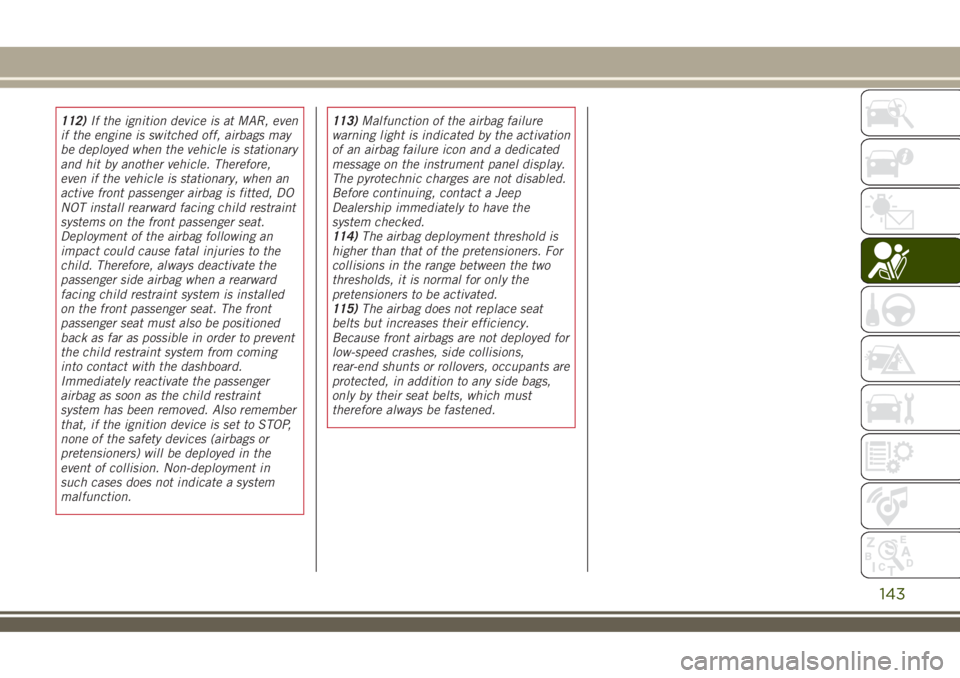
112)If the ignition device is at MAR, even
if the engine is switched off, airbags may
be deployed when the vehicle is stationary
and hit by another vehicle. Therefore,
even if the vehicle is stationary, when an
active front passenger airbag is fitted, DO
NOT install rearward facing child restraint
systems on the front passenger seat.
Deployment of the airbag following an
impact could cause fatal injuries to the
child. Therefore, always deactivate the
passenger side airbag when a rearward
facing child restraint system is installed
on the front passenger seat. The front
passenger seat must also be positioned
back as far as possible in order to prevent
the child restraint system from coming
into contact with the dashboard.
Immediately reactivate the passenger
airbag as soon as the child restraint
system has been removed. Also remember
that, if the ignition device is set to STOP,
none of the safety devices (airbags or
pretensioners) will be deployed in the
event of collision. Non-deployment in
such cases does not indicate a system
malfunction.113)Malfunction of the airbag failure
warning light is indicated by the activation
of an airbag failure icon and a dedicated
message on the instrument panel display.
The pyrotechnic charges are not disabled.
Before continuing, contact a Jeep
Dealership immediately to have the
system checked.
114)The airbag deployment threshold is
higher than that of the pretensioners. For
collisions in the range between the two
thresholds, it is normal for only the
pretensioners to be activated.
115)The airbag does not replace seat
belts but increases their efficiency.
Because front airbags are not deployed for
low-speed crashes, side collisions,
rear-end shunts or rollovers, occupants are
protected, in addition to any side bags,
only by their seat belts, which must
therefore always be fastened.
143
Page 147 of 356
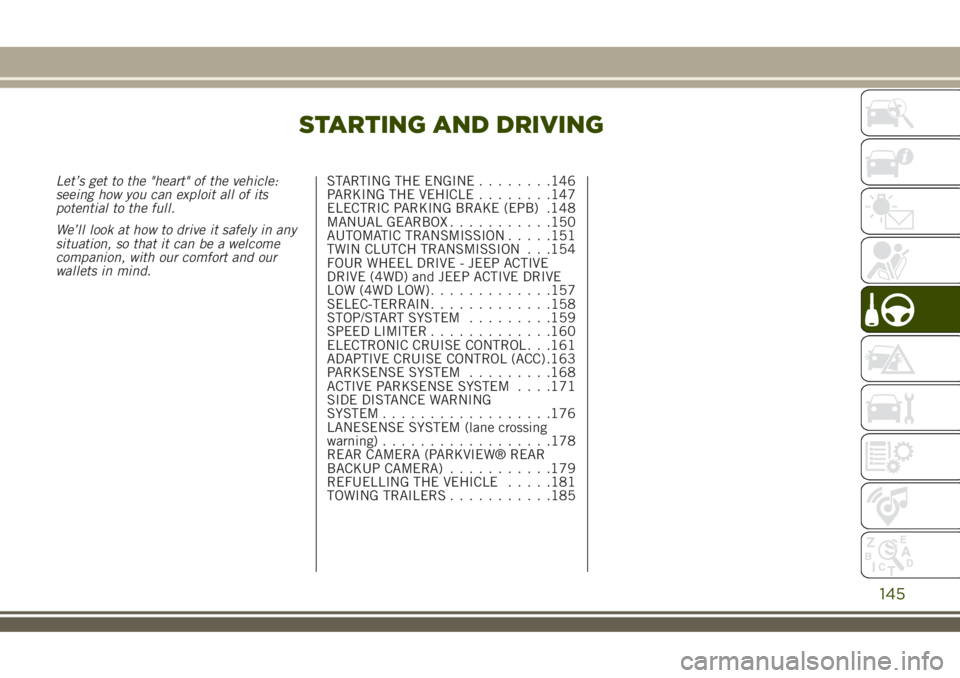
STARTING AND DRIVING
Let’s get to the "heart" of the vehicle:
seeing how you can exploit all of its
potential to the full.
We’ll look at how to drive it safely in any
situation, so that it can be a welcome
companion, with our comfort and our
wallets in mind.STARTING THE ENGINE........146
PARKING THE VEHICLE........147
ELECTRIC PARKING BRAKE (EPB) .148
MANUAL GEARBOX...........150
AUTOMATIC TRANSMISSION.....151
TWIN CLUTCH TRANSMISSION . . .154
FOUR WHEEL DRIVE - JEEP ACTIVE
DRIVE (4WD) and JEEP ACTIVE DRIVE
LOW (4WD LOW).............157
SELEC-TERRAIN.............158
STOP/START SYSTEM.........159
SPEED LIMITER.............160
ELECTRONIC CRUISE CONTROL . . .161
ADAPTIVE CRUISE CONTROL (ACC) .163
PARKSENSE SYSTEM.........168
ACTIVE PARKSENSE SYSTEM. . . .171
SIDE DISTANCE WARNING
SYSTEM..................176
LANESENSE SYSTEM (lane crossing
warning)..................178
REAR CAMERA (PARKVIEW® REAR
BACKUP CAMERA)...........179
REFUELLING THE VEHICLE.....181
TOWING TRAILERS...........185
145
Page 148 of 356
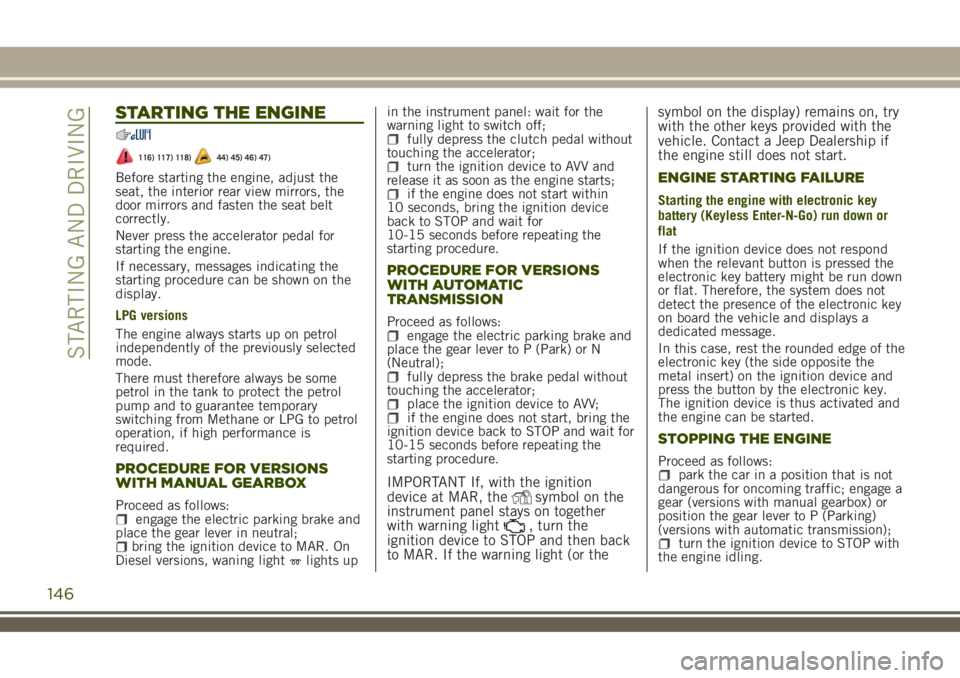
STARTING THE ENGINE
116) 117) 118)44) 45) 46) 47)
Before starting the engine, adjust the
seat, the interior rear view mirrors, the
door mirrors and fasten the seat belt
correctly.
Never press the accelerator pedal for
starting the engine.
If necessary, messages indicating the
starting procedure can be shown on the
display.
LPG versions
The engine always starts up on petrol
independently of the previously selected
mode.
There must therefore always be some
petrol in the tank to protect the petrol
pump and to guarantee temporary
switching from Methane or LPG to petrol
operation, if high performance is
required.
PROCEDURE FOR VERSIONS
WITH MANUAL GEARBOX
Proceed as follows:engage the electric parking brake and
place the gear lever in neutral;
bring the ignition device to MAR. On
Diesel versions, waning lightlights upin the instrument panel: wait for the
warning light to switch off;
fully depress the clutch pedal without
touching the accelerator;
turn the ignition device to AVV and
release it as soon as the engine starts;
if the engine does not start within
10 seconds, bring the ignition device
back to STOP and wait for
10-15 seconds before repeating the
starting procedure.
PROCEDURE FOR VERSIONS
WITH AUTOMATIC
TRANSMISSION
Proceed as follows:engage the electric parking brake and
place the gear lever to P (Park) or N
(Neutral);
fully depress the brake pedal without
touching the accelerator;
place the ignition device to AVV;if the engine does not start, bring the
ignition device back to STOP and wait for
10-15 seconds before repeating the
starting procedure.
IMPORTANT If, with the ignition
device at MAR, thesymbol on the
instrument panel stays on together
with warning light
, turn the
ignition device to STOP and then back
to MAR. If the warning light (or thesymbol on the display) remains on, try
with the other keys provided with the
vehicle. Contact a Jeep Dealership if
the engine still does not start.
ENGINE STARTING FAILURE
Starting the engine with electronic key
battery (Keyless Enter-N-Go) run down or
flat
If the ignition device does not respond
when the relevant button is pressed the
electronic key battery might be run down
or flat. Therefore, the system does not
detect the presence of the electronic key
on board the vehicle and displays a
dedicated message.
In this case, rest the rounded edge of the
electronic key (the side opposite the
metal insert) on the ignition device and
press the button by the electronic key.
The ignition device is thus activated and
the engine can be started.
STOPPING THE ENGINE
Proceed as follows:park the car in a position that is not
dangerous for oncoming traffic; engage a
gear (versions with manual gearbox) or
position the gear lever to P (Parking)
(versions with automatic transmission);
turn the ignition device to STOP with
the engine idling.
146
STARTING AND DRIVING
Page 149 of 356
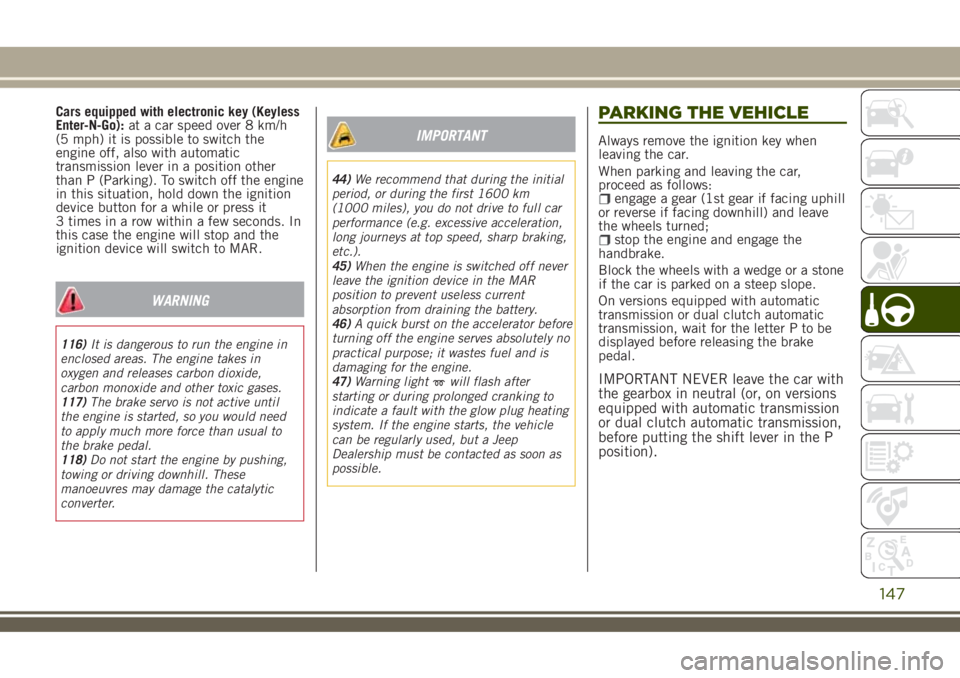
Cars equipped with electronic key (Keyless
Enter-N-Go):at a car speed over 8 km/h
(5 mph) it is possible to switch the
engine off, also with automatic
transmission lever in a position other
than P (Parking). To switch off the engine
in this situation, hold down the ignition
device button for a while or press it
3 times in a row within a few seconds. In
this case the engine will stop and the
ignition device will switch to MAR.
WARNING
116)It is dangerous to run the engine in
enclosed areas. The engine takes in
oxygen and releases carbon dioxide,
carbon monoxide and other toxic gases.
117)The brake servo is not active until
the engine is started, so you would need
to apply much more force than usual to
the brake pedal.
118)Do not start the engine by pushing,
towing or driving downhill. These
manoeuvres may damage the catalytic
converter.
IMPORTANT
44)We recommend that during the initial
period, or during the first 1600 km
(1000 miles), you do not drive to full car
performance (e.g. excessive acceleration,
long journeys at top speed, sharp braking,
etc.).
45)When the engine is switched off never
leave the ignition device in the MAR
position to prevent useless current
absorption from draining the battery.
46)A quick burst on the accelerator before
turning off the engine serves absolutely no
practical purpose; it wastes fuel and is
damaging for the engine.
47)Warning light
will flash after
starting or during prolonged cranking to
indicate a fault with the glow plug heating
system. If the engine starts, the vehicle
can be regularly used, but a Jeep
Dealership must be contacted as soon as
possible.
PARKING THE VEHICLE
Always remove the ignition key when
leaving the car.
When parking and leaving the car,
proceed as follows:
engage a gear (1st gear if facing uphill
or reverse if facing downhill) and leave
the wheels turned;
stop the engine and engage the
handbrake.
Block the wheels with a wedge or a stone
if the car is parked on a steep slope.
On versions equipped with automatic
transmission or dual clutch automatic
transmission, wait for the letter P to be
displayed before releasing the brake
pedal.
IMPORTANT NEVER leave the car with
the gearbox in neutral (or, on versions
equipped with automatic transmission
or dual clutch automatic transmission,
before putting the shift lever in the P
position).
147